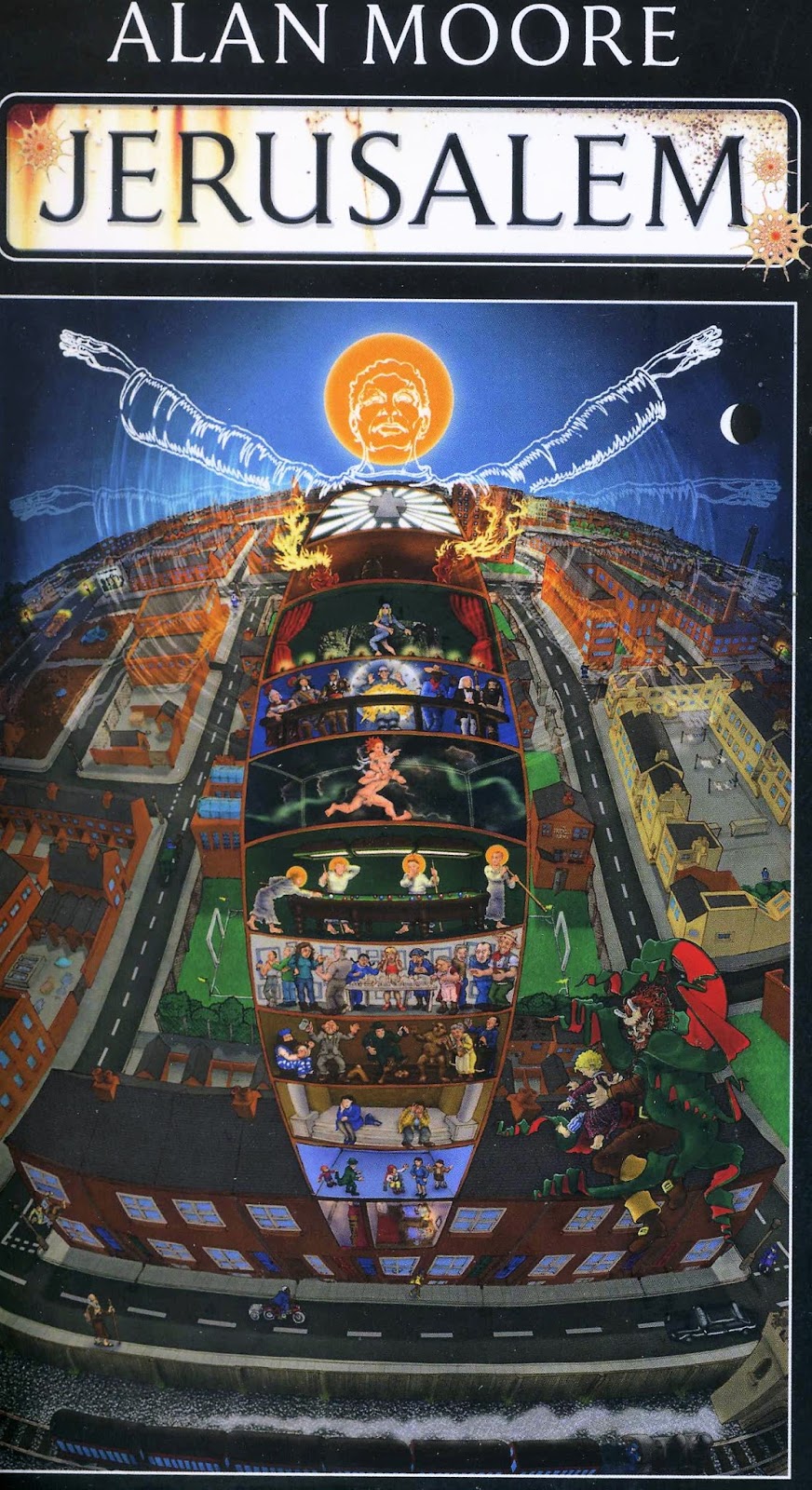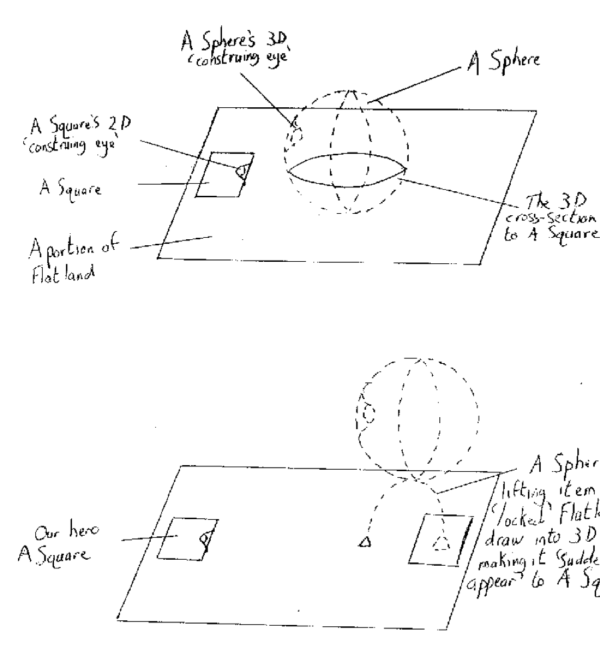What We’re Reading: Jerusalem, Part 1

 One of Hazel & Wren’s New Year resolutions is to find new ways to engage with and review books. You’ve already seen our review roundups, and here’s another grand experiment: a yearlong, co-reviewed readalong of Alan Moore’s newest novel, Jerusalem.
One of Hazel & Wren’s New Year resolutions is to find new ways to engage with and review books. You’ve already seen our review roundups, and here’s another grand experiment: a yearlong, co-reviewed readalong of Alan Moore’s newest novel, Jerusalem.
Jerusalem is 1,200 pages of magical realism, historical fiction, and experimental prose about Northampton, England. Each month, we’ll read approximately 100 pages and post a short roundtable discussion. And the coolest part? You can read along and join the discussion! Let’s pick this beast of a book apart.
This month, Josh and Aaron will be discussing the first 97 pages. With 1,100 pages to go, there’s still time for you to grab a copy and join in.
Aaron: A majority of the first 100 pages is about members of the Vernall family across generations. One restores church frescoes in the late 19th century. Others paint and dream in the modern day. All of them suffer from mental illness.
First of all, it feels like this is going to be a book about perspective. Alma’s opening scene is about architecture and angles, and she thinks about the family madness in metaphor, pondering those ancestors who’ve gone round the turn, the bend, the twist, effectively disappearing from view. Mental illness makes someone invisible, no longer able to be perceived in traditional ways.
Josh: It’s a curious way to start a book, right? It at once lets us know the scope of this thing he’s given us, the truly omniscient attempts at narration. It’s as though Moore wants to be clear with us right from the get-go: this book will shy away from no consideration of place, person, or perspective, so buckle up. It reminds me of Mervyn Peake’s Gormenghast books wherein Peake is happy—thrilled, even—to spend huge amounts of time widening his perspectival scope, not for considerations of plot or even character but because of his fidelity to truth, as though you can only really understand a person in a place by totally and completely seeing/understanding the place itself. This seems to be a touch of what Moore is after here right from the start.
A: The Gormenghast reference is a perfect one! I loved how inseparable Peake’s prose was—labyrinthine, precarious, and unexpected—from the shape of Gormenghast Castle. It forced the reader to experience from the perspective of the characters.
And speaking of characters’ perspectives, when Ginger Vernall is raised up to paint a chapel ceiling, he has the pleasure of looking down on two monks coming around a corner at the same time. Ginger knows beforehand that they’re going to collide before it happens; in the right conditions, perspective can be the same thing as precognition.
Are the strange visions the characters suffer also a consequence of a changed perspective? And does that perspective shift come from their mental illness, or does the madness come from a changed perspective? Or it something more magical, more science-fictional? Are there actual angels and demons who are viewing us from a higher dimension and thus appear to teleport or extrude themselves into our world in weird ways a la Flatland?
(diagram from Flatland)
J: I’ve been wondering some of this same stuff, too! The supernatural, such as it is, walks a really thin line here, I think. The elision of madness and magic is well-trod territory and can verge on offensive when romanticized, but Moore seems really interested in showing both sides of that line: the beauty and wonder of seeing angels building in the middle of the night juxtaposed with lives and bodies and minds broken, seemingly irreparably.
I’m curious to read more and see how the book continues to make use of the supernatural forces here that seem to be flittering around the edges of things, coming forward at moments and hanging back at others.
A: Taking a turn from the supernatural to the realistic: Jerusalem also feels like a book about the working class. Moore’s Northampton is poor and dirty, full of damaged infrastructure , subsidized housing, and CCTV cameras. Food is scarce in Ginger’s time, and pubs are empty in the present day. No one has money to spend, but they work all the time. With so many novels about writers, professors, and other white-collar workers, it’s nice to read something about the blue collars.
J: Yes! I was thinking this same thing. I’m fascinated by the way Moore navigates space in this book; it feels very Dickensian to me. Class (and specifically the working class) seems to somehow thrive in these tight, sometimes-grubby, carefully described, much loved spaces, especially since most of the spaces in this book become defined by their workability. Even the sense of beauty Moore finds in this place is often wrapped up in industrialization of some sort.
“A fat pearl cylinder of failing daylight coloured by the worsening storm outside dropped from the windows of the Whispering Gallery to the cathedral’s flooring down below, dust lifted by the bustling industry caught up as suspension in its filmy shaft” (50).
A: And being stuck in the working class, being stuck in a dead-end job or with a drug addiction like Marla has in the third section of the book—that’s its own form of perspective limitation. Marla herself hints at it when she’s thinking about her drug addiction:
“Not feeling like a fucking angel on fire, forget that, that’s not going to happen for you anymore, no, no, just feeling like a fucking person like you was again for just ten fucking minutes, that’s your fucking big ambition these days. Heaven, where you went the first time, that’s all shut. The ordinary world you used to be in, that’s shut too, most of the time, and you’re stuck somewhere else, somewhere that’s under all of that, like being under fucking ground.”
Marla, as a person of color, a sex worker, and a drug addict, has had her perspective squashed like a Flatlander’s. She can’t see up or down, only looking forward.
J: Your ideas about perspective limitation are really great, and Marla is a great example of this. She has such a complicated relationship with memory—she seems to be a character at once struggling to keep one foot out of the past and the other in her present. I keep thinking of her interaction with that fellow on the street—the one with the big nose who Marla tries to take a run at. I wonder about how that interaction gets narrated, with Marla continuously running into her inability to figure this guy out, getting caught up on his strange speech, unable somehow to extend her perspective deeper into who he might be or what might be going on with him (beyond just calling him “really mental”).
I’m wondering about the place of the reader in this book. At times during these first 100 or so pages, I felt encouraged—even demanded—to pay really close attention to detail in the text. Moore pushes off plot in favor of this encyclopedic lens—every detail, significance thrown out the window, recorded and captured. And so I invest myself where he asks me to, but there are times where I feel a little punished for that investment. I end up overloaded, juggling information (like reading one of the great Russian novels and trying to keep characters straight in your head) that I have no idea how to prioritize. Did you experience anything like that?
A: Not consciously, but now that you brought it up, jeez! So many thoughts.
When I started the book, when I was walking through that first dream world, I definitely considered keeping a list of characters and relationships and terms I didn’t understand—with everything being given that same encyclopedic (great term for it, by the way) weight, I was left without the traditional narrative signals of, “Hey, this thing is important!”
Feeling that way, though, always pulls me in two directions. The first is, “Everything is important and I must keep track of it all.” That was the note-taking instinct…which I ignored, because I’m a terrible student. Instead, I ended up where I always end up—with everything being given the same narrative weight, I felt like it was up to me to choose what was important to me. With everyone in the book walking everywhere (which is probably something I’ll come back to), I get the pleasure of walking along with them, focusing on things that catch my eye and letting my eyes glaze over if they need to. But maybe I’m just a bad reader. Regardless, it reminded me (probably on purpose) of Mrs Dalloway and Ulysses and all the other British walking-around novels.
Next month, we’re reading to page 207. Please join us!
Supplemental reading:
Flatland: A Romance of Many Dimensions (1884) by Edwin Abbott Abbott
Titus Groan (1946), Gormenghast (1950), and Titus Alone (1959) by Mervyn Peake
Mrs Dalloway (1925) by Virginia Woolf






